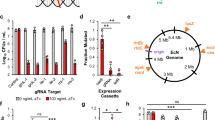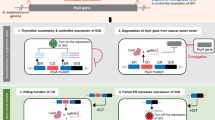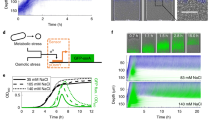Abstract
Biocontainment systems that couple environmental sensing with circuit-based control of cell viability could be used to prevent escape of genetically modified microbes into the environment. Here we present two engineered safeguard systems known as the 'Deadman' and 'Passcode' kill switches. The Deadman kill switch uses unbalanced reciprocal transcriptional repression to couple a specific input signal with cell survival. The Passcode kill switch uses a similar two-layered transcription design and incorporates hybrid LacI-GalR family transcription factors to provide diverse and complex environmental inputs to control circuit function. These synthetic gene circuits efficiently kill Escherichia coli and can be readily reprogrammed to change their environmental inputs, regulatory architecture and killing mechanism.
This is a preview of subscription content, access via your institution
Access options
Subscribe to this journal
Receive 12 print issues and online access
$259.00 per year
only $21.58 per issue
Buy this article
- Purchase on Springer Link
- Instant access to full article PDF
Prices may be subject to local taxes which are calculated during checkout




Similar content being viewed by others
References
Moe-Behrens, G.H., Davis, R. & Haynes, K.A. Preparing synthetic biology for the world. Front. Microbiol. 4, 5 (2013).
Bacchus, W., Aubel, D. & Fussenegger, M. Biomedically relevant circuit-design strategies in mammalian synthetic biology. Mol. Syst. Biol. 9, 691 (2013).
Olson, E.J. & Tabor, J.J. Post-translational tools expand the scope of synthetic biology. Curr. Opin. Chem. Biol. 16, 300–306 (2012).
Wright, O., Delmans, M., Stan, G.B. & Ellis, T. GeneGuard: a modular plasmid system designed for biosafety. ACS Synth. Biol. 4, 307–316 (2015).
Chappell, J. et al. The centrality of RNA for engineering gene expression. Biotechnol. J. 8, 1379–1395 (2013).
Cameron, D.E., Bashor, C.J. & Collins, J.J. A brief history of synthetic biology. Nat. Rev. Microbiol. 12, 381–390 (2014).
Wright, O., Stan, G.B. & Ellis, T. Building-in biosafety for synthetic biology. Microbiology 159, 1221–1235 (2013).
Steidler, L. et al. Biological containment of genetically modified Lactococcus lactis for intestinal delivery of human interleukin 10. Nat. Biotechnol. 21, 785–789 (2003).
Rovner, A.J. et al. Recoded organisms engineered to depend on synthetic amino acids. Nature 518, 89–93 (2015).
Mandell, D.J. et al. Biocontainment of genetically modified organisms by synthetic protein design. Nature 518, 55–60 (2015).
Callura, J.M., Dwyer, D.J., Isaacs, F.J., Cantor, C.R. & Collins, J.J. Tracking, tuning, and terminating microbial physiology using synthetic riboregulators. Proc. Natl. Acad. Sci. USA 107, 15898–15903 (2010).
Contreras, A., Molin, S. & Ramos, J.L. Conditional-suicide containment system for bacteria which mineralize aromatics. Appl. Environ. Microbiol. 57, 1504–1508 (1991).
Cai, Y. et al. Intrinsic biocontainment: multiplex genome safeguards combine transcriptional and recombinational control of essential yeast genes. Proc. Natl. Acad. Sci. USA 112, 1803–1808 (2015).
Gallagher, R.R., Patel, J.R., Interiano, A.L., Rovner, A.J. & Isaacs, F.J. Multilayered genetic safeguards limit growth of microorganisms to defined environments. Nucleic Acids Res. 43, 1945–1954 (2015).
Voigt, C.A. Genetic parts to program bacteria. Curr. Opin. Biotechnol. 17, 548–557 (2006).
Jensen, L.B., Ramos, J.L., Kaneva, Z. & Molin, S. A substrate-dependent biological containment system for Pseudomonas putida based on the Escherichia coli gef gene. Appl. Environ. Microbiol. 59, 3713–3717 (1993).
Litcofsky, K.D., Afeyan, R.B., Krom, R.J., Khalil, A.S. & Collins, J.J. Iterative plug-and-play methodology for constructing and modifying synthetic gene networks. Nat. Methods 9, 1077–1080 (2012).
Gardner, T.S., Cantor, C.R. & Collins, J.J. Construction of a genetic toggle switch in Escherichia coli. Nature 403, 339–342 (2000).
Sadler, J.R., Sasmor, H. & Betz, J.L. A perfectly symmetric lac operator binds the lac repressor very tightly. Proc. Natl. Acad. Sci. USA 80, 6785–6789 (1983).
Cameron, D.E. & Collins, J.J. Tunable protein degradation in bacteria. Nat. Biotechnol. 32, 1276–1281 (2014).
Cheng, S.C., Kim, R., King, K., Kim, S.H. & Modrich, P. Isolation of gram quantities of EcoRI restriction and modification enzymes from an overproducing strain. J. Biol. Chem. 259, 11571–11575 (1984).
Smith, A.B. & Maxwell, A. A strand-passage conformation of DNA gyrase is required to allow the bacterial toxin, CcdB, to access its binding site. Nucleic Acids Res. 34, 4667–4676 (2006).
Zhang, Y. et al. MazF cleaves cellular mRNAs specifically at ACA to block protein synthesis in Escherichia coli. Mol. Cell 12, 913–923 (2003).
Salis, H.M. The ribosome binding site calculator. Methods Enzymol. 498, 19–42 (2011).
Meinhardt, S. & Swint-Kruse, L. Experimental identification of specificity determinants in the domain linker of a LacI/GalR protein: bioinformatics-based predictions generate true positives and false negatives. Proteins 73, 941–957 (2008).
Meinhardt, S. et al. Novel insights from hybrid LacI/GalR proteins: family-wide functional attributes and biologically significant variation in transcription repression. Nucleic Acids Res. 40, 11139–11154 (2012).
Shis, D.L., Hussain, F., Meinhardt, S., Swint-Kruse, L. & Bennett, M.R. Modular, multi-input transcriptional logic gating with orthogonal LacI/GalR family chimeras. ACS Synth. Biol. 3, 645–651 (2014).
Sousa, A., Bourgard, C., Wahl, L.M. & Gordo, I. Rates of transposition in Escherichia coli. Biol. Lett. 9, 20130838 (2013).
Cuthbertson, L. & Nodwell, J.R. The TetR family of regulators. Microbiol. Mol. Biol. Rev. 77, 440–475 (2013).
Finn, R.D. et al. Pfam: the protein families database. Nucleic Acids Res. 42, D222–D230 (2014).
Ramos, J.L. et al. The TetR family of transcriptional repressors. Microbiol. Mol. Biol. Rev. 69, 326–356 (2005).
Cebolla, A., Vázquez, M.E. & Palomares, A.J. Expression vectors for the use of eukaryotic luciferases as bacterial markers with different colors of luminescence. Appl. Environ. Microbiol. 61, 660–668 (1995).
Mignon, C., Sodoyer, R. & Werle, B. Antibiotic-free selection in biotherapeutics: now and forever. Pathogens 4, 157–181 (2015).
Csörgo, B., Fehér, T., Tímár, E., Blattner, F.R. & Pósfai, G. Low-mutation-rate, reduced-genome Escherichia coli: an improved host for faithful maintenance of engineered genetic constructs. Microb. Cell Fact. 11, 11 (2012).
Larkin, M.A. et al. Clustal W and Clustal X version 2.0. Bioinformatics 23, 2947–2948 (2007).
Bell, C.E. & Lewis, M. A closer view of the conformation of the Lac repressor bound to operator. Nat. Struct. Biol. 7, 209–214 (2000).
Friedman, A.M., Fischmann, T.O. & Steitz, T.A. Crystal structure of lac repressor core tetramer and its implications for DNA looping. Science 268, 1721–1727 (1995).
Lewis, M. et al. Crystal structure of the lactose operon repressor and its complexes with DNA and inducer. Science 271, 1247–1254 (1996).
Schumacher, M.A., Choi, K.Y., Lu, F., Zalkin, H. & Brennan, R.G. Mechanism of corepressor-mediated specific DNA binding by the purine repressor. Cell 83, 147–155 (1995).
Glasfeld, A., Koehler, A.N., Schumacher, M.A. & Brennan, R.G. The role of lysine 55 in determining the specificity of the purine repressor for its operators through minor groove interactions. J. Mol. Biol. 291, 347–361 (1999).
Baba, T. et al. Construction of Escherichia coli K-12 in-frame, single-gene knockout mutants: the Keio collection. Mol. Syst. Biol. 2, 2006.0008 (2006).
Datsenko, K.A. & Wanner, B.L. One-step inactivation of chromosomal genes in Escherichia coli K-12 using PCR products. Proc. Natl. Acad. Sci. USA 97, 6640–6645 (2000).
Sambrook, J., Fritsch, E.F. & Maniatis, T. Molecular Cloning: A Laboratory Manual (Cold Spring Harbor Laboratory Press, 1982).
Gibson, D.G. et al. Enzymatic assembly of DNA molecules up to several hundred kilobases. Nat. Methods 6, 343–345 (2009).
Wild, J., Hradecna, Z. & Szybalski, W. Conditionally amplifiable BACs: switching from single-copy to high-copy vectors and genomic clones. Genome Res. 12, 1434–1444 (2002).
Lutz, R. & Bujard, H. Independent and tight regulation of transcriptional units in Escherichia coli via the LacR/O, the TetR/O and AraC/I1-I2 regulatory elements. Nucleic Acids Res. 25, 1203–1210 (1997).
Acknowledgements
We thank J. Han for assistance with molecular cloning. This work was supported by funding from the Defense Threat Reduction Agency grant HDTRA1-14-1-0006, Office of Naval Research MURI grant N000141110725, Air Force Office of Scientific Research grant FA9550-14-1-0060 and the Howard Hughes Medical Institute.
Author information
Authors and Affiliations
Contributions
C.T.Y.C., J.W.L., D.E.C., C.J.B. and J.J.C. designed the study, analyzed data and wrote the paper. C.T.Y.C. and J.W.L. performed the experiments.
Corresponding author
Ethics declarations
Competing interests
The authors have filed a provisional application with the US Patent and Trademark Office on this work.
Supplementary information
Supplementary Text and Figures
Supplementary Results, Supplementary Figures 1–21 and Supplementary Table 1. (PDF 12918 kb)
Rights and permissions
About this article
Cite this article
Chan, C., Lee, J., Cameron, D. et al. 'Deadman' and 'Passcode' microbial kill switches for bacterial containment. Nat Chem Biol 12, 82–86 (2016). https://doi.org/10.1038/nchembio.1979
Received:
Accepted:
Published:
Issue Date:
DOI: https://doi.org/10.1038/nchembio.1979
This article is cited by
-
A bumpy road ahead for genetic biocontainment
Nature Communications (2024)
-
Engineering stringent genetic biocontainment of yeast with a protein stability switch
Nature Communications (2024)
-
Recent advances in single-cell engineered live biotherapeutic products research for skin repair and disease treatment
npj Biofilms and Microbiomes (2023)
-
Steering and controlling evolution — from bioengineering to fighting pathogens
Nature Reviews Genetics (2023)
-
Programming bacteria for multiplexed DNA detection
Nature Communications (2023)



